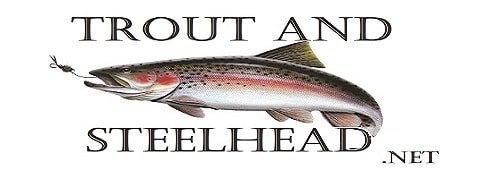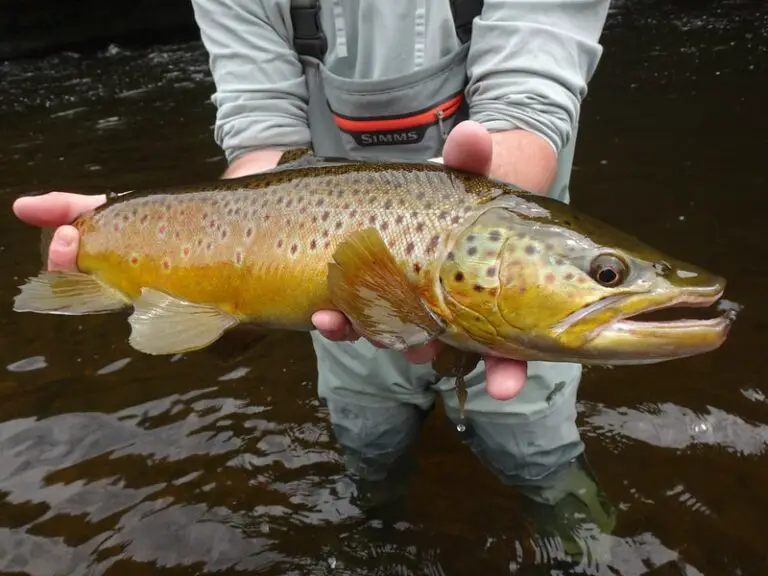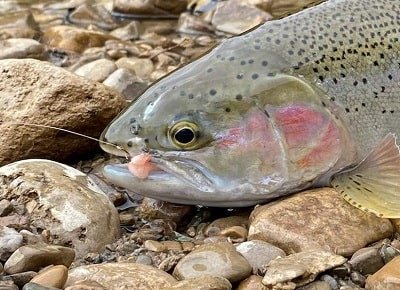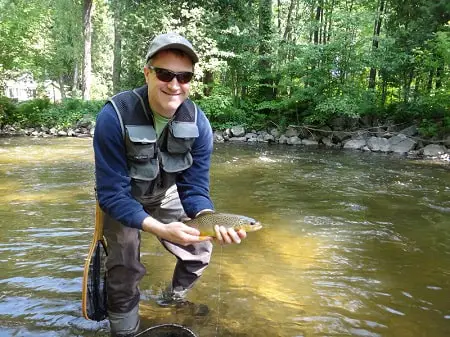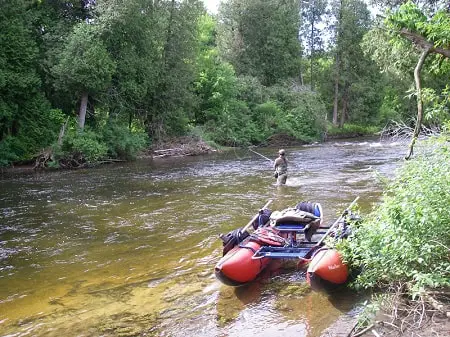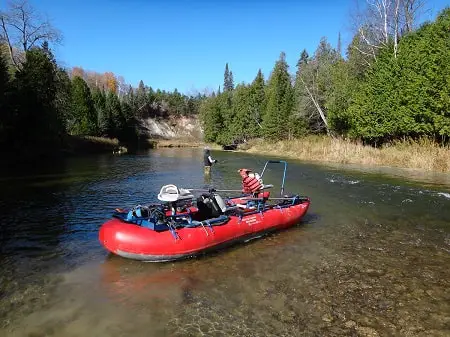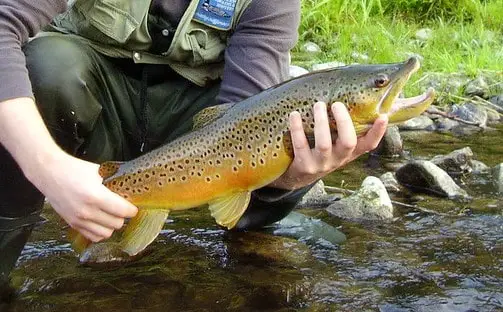Rainbow Trout Fishing At Night: Expert Tips and Tactics
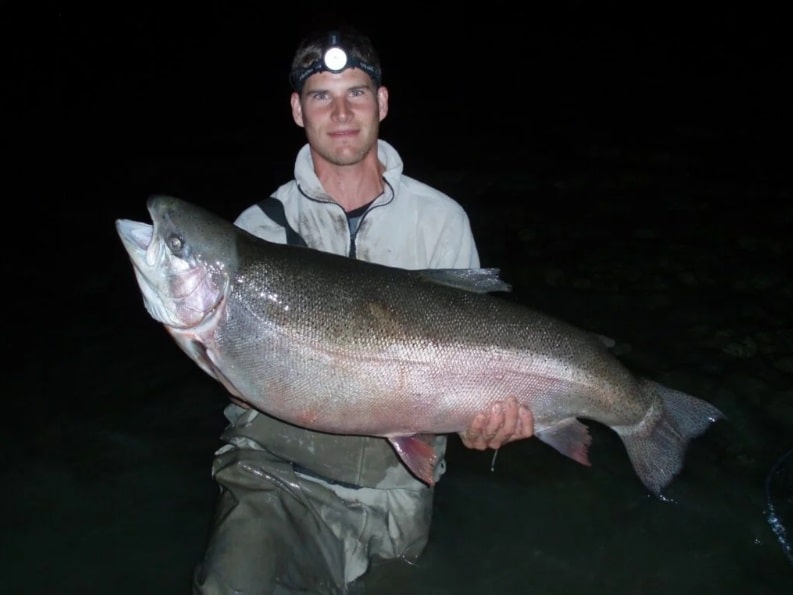
As a guide and angler, I know there are challenges and potential hazards associated with nighttime rainbow trout fishing, but I also know there is potential to catch some of the largest rainbow trout at night.
I have caught many rainbows during the night as well as just before dark and at sunrise. I have discovered some things that made things easier for my clients and increased their success in catching rainbow trout at night.
In this article, I will share my valuable tips and advice.
Do Rainbow Trout Bite at Night?
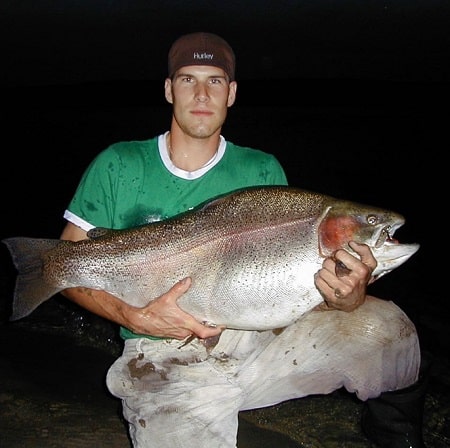
In many cases, rainbow trout do bite at night, especially during the warmer months of the year.
In fact, trout may even feed more actively at night than during the day under some circumstances such as more food, daytime fishing pressure, and cooler water temps at night.
Despite their nocturnal feeding habits, night fishing for rainbow trout can be quite challenging for many anglers.
Let’s shed some light on the subject of fishing for rainbow trout in the dark.
Are Rainbow Trout More Active at Night?
I don’t believe rainbow trout are more active at night, however, they can be active, and at times they can be even more active than during the day.
Determining whether rainbow trout are more active at night depends on various factors. At times, rainbow trout may exhibit higher activity levels at night, while in other instances, they might be less active.
Additionally, there are situations where trout fishing activity remains consistent throughout the day and night.
Understanding that rainbow trout behavior can vary from night to night is important. Rainbow trout fishing can be good during the day if you know the best methods and best baits and night fishing is no different.
Best Time to Fish for Rainbow Trout at Night
The optimal time for fishing rainbow trout at night is during the full moon or the four nights leading up to and following the full moon. Rainbow trout tend to display increased aggression during this lunar phase, and the additional moonlight enhances night vision.
While fishing on moonless nights can also be productive, visibility becomes significantly challenging for anglers.
Cloudy nights pose another difficulty as they intensify darkness, making it harder to fish effectively.
Why Do Rainbow Trout Bite At Night?
There are three primary reasons why rainbow trout are more prone to biting at night:
- Abundance of Food: Insects, such as moths, crickets, mosquitoes, and mayflies, tend to be more active just before dark. These insects often end up in the river, attracting baitfish and smaller trout, which, in turn, entice the larger rainbow trout. Nightcrawlers are also more prevalent during nighttime, earning their name.
- Reduced Angler Pressure: In rivers where angler activity is high, rainbow trout may reduce their feeding or become more nocturnal. The larger and more experienced rainbow trout often shift their feeding patterns to nighttime when they face increased pressure during the day.
- Cooler Water Temperature: During hot summer periods, rainbow trout are most active and feed during the last hour before dark, throughout the night, and into the first three to four hours after sunrise. Consequently, rainbow trout tend to feed more actively at night due to the cooler water temperatures.
The Downside of Night Fishing for Rainbow Trout
Before embarking on a fishing trip after dark, it’s crucial to consider the potential downsides of night fishing:
- Limited Visibility: Darkness severely hampers visibility, particularly in forested areas. Anglers are at higher risk of accidents such as falling down banks, stumbling into holes or depressions, getting hit by branches, losing their way, or hooking unintended objects.
- Casting and Targeting Challenges: In the absence of adequate visibility, properly covering the water and accurately targeting rainbow trout becomes considerably more challenging.
- Strike Detection: Detecting bites when using bait fishing techniques becomes significantly more difficult due to the reduced visibility of the line or float.
- Tangles: Untangling lines is particularly difficult in the dark, posing a significant challenge, especially for less experienced anglers.
Tips for Night Fishing for Rainbow Trout
Based on my extensive experience, I have discovered effective techniques to
make night fishing for rainbow trout more successful. Here are my top tips:
- Familiarize Yourself with the Area: Stick to fishing spots or areas you are already familiar with. Exploring new waters at night can be risky and may result in getting lost or encountering potentially dangerous situations. Prioritize safety by sticking to known locations.
- Equip Yourself with a Headlamp and Spare Batteries: Invest in a high-quality headlamp that provides ample brightness for navigating trails, crossing rivers, netting fish, and releasing them. Always carry spare batteries to ensure you have sufficient light throughout your fishing trip. Some anglers prefer red light headlamps for fishing, as they provide adequate visibility while preserving night vision. However, brighter lights are essential for trail navigation.
- Slow Down Your Movements: Moving slowly both on the trail and in the river is crucial to avoid startling rainbow trout. These fish can still be spooked at night, so maintain a calm and deliberate pace to increase your chances of success.
- Inform Someone of Your Plans: Always inform a reliable person about your fishing plans, including the location and estimated return time. This ensures that someone is aware of your whereabouts in case of emergencies or if you encounter any difficulties during your trip.
Where to Locate Rainbow Trout at Night
The behavior of rainbow trout at night differs based on their size. Smaller rainbow trout tend to remain close to their daytime locations to avoid becoming prey to larger fish. They usually stay away from areas inhabited by big fish.
On the other hand, larger rainbow trout exhibit different behavior patterns. During the day, they tend to rest in deep holes. However, at night, these larger trout venture into shallower water and explore different areas of the river in search of food. They target smaller fish, minnows, crawfish, and other potential prey.
In lakes, you may catch rainbow trout very close to shore and in shallow water. They will move out of their daytime deep water holding areas and up onto structure and shoreline to feed.
Therefore, focus your fishing efforts on shallower waters, including depths as shallow as six inches, to increase your chances of encountering these larger rainbow trout.
How to Fish for Rainbow Trout at Night
When it comes to fishing methods for rainbow trout at night, you can employ various techniques with some adjustments to ensure effectiveness in low-light conditions. Consider the following methods:
- Float Fishing: Drifting bait slowly down the river under a float is an excellent technique for catching rainbow trout at night. Adjust your presentation to account for reduced visibility. See Float Fishing For Trout.
- Fly Fishing at Night: Fly fishing can also be successful at night, particularly for experienced anglers. However, ensure that you are well-acquainted with your surroundings to minimize tangling and improve your chances of presenting the fly effectively.
- Lure Fishing: Lure fishing with appropriate adjustments can yield great results when targeting rainbow trout at night. Opt for lures that have a straight, steady movement, as they are easier for the trout to spot and strike. Consider using noisy lures with vibration or those equipped with rattles to increase their detectability. Retrieve your lures at a slower pace to give the rainbow trout ample time to detect and strike them.
- Drift Fishing and Bottom Bouncing: Drift fishing and bottom bouncing can be effective techniques for presenting baits without a float. However, detecting bites can be challenging in low-light conditions, so be attentive to subtle changes in your line or rod tip.
Bait Fishing Tips and Advice for Night Fishing
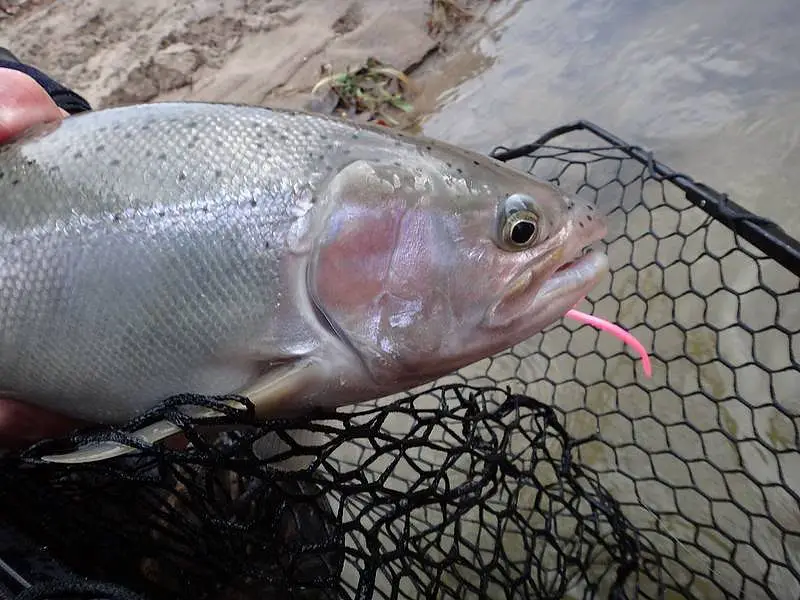
Bait fishing can be highly effective for rainbow trout at night, primarily due to the slow movement of the bait and its scent, which can attract fish in reduced visibility. Consider the following tips:
- Use a River-Style Float: Utilize a high-quality river-style float like the Raven Premium Balsa Floats for bait fishing. This allows for controlled presentation and increases your chances of enticing rainbow trout.
- Focus on Slower, Deeper Water: Pay close attention to slower and deeper water when bait fishing for rainbow trout at night. The reduced water flow in these areas allows the bait to move at a slower pace, making it more visible to the fish.
Best Bait for Rainbow Trout Fishing at Night
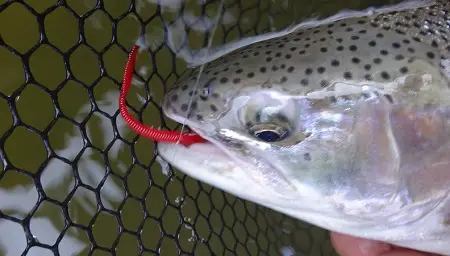
When it comes to selecting bait for night fishing, opt for live or organic baits that emit a strong scent. Rainbow trout have a keen sense of smell, which becomes even more critical in low-light conditions.
Consider using small to medium-sized worms, spawn sacs, grubs, maggots, leeches, crayfish, and minnows as effective baits for attracting rainbow trout at night.
Focus your efforts on presenting the bait in slower water areas, where the scent can disperse more effectively, increasing the chances of enticing rainbow trout to bite.
Rainbow Trout Fishing at Night with Worms
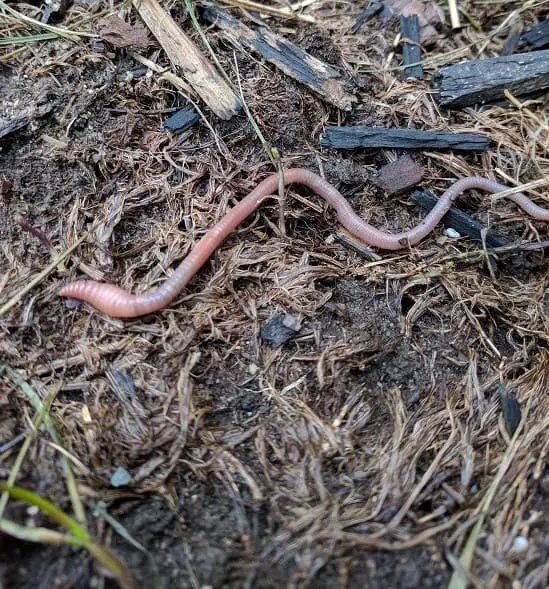
Live worms are a go-to bait for many anglers when targeting rainbow trout at night. To maximize success, avoid the common mistake of balling up the worm on the hook.
Instead, hook the live worm once or twice through the body, allowing it to maintain movement and appear more natural to the trout.
This creates a larger profile that is easier for rainbow trout to detect, increasing your chances of bites.
Lure Fishing for Rainbow Trout at Night
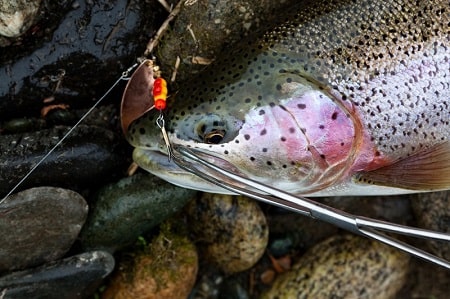
Lure fishing can be highly effective for rainbow trout at night when using the right techniques.
Consider the following tips:
- Opt for Straight Lures: Choose lures that have a straight, steady movement. Avoid jerky or twitchy movements, as they can make it more challenging for rainbow trout to track and strike the lure.
- Use Noisy Lures: Select lures that produce noise or vibrations, such as spinners with a strong vibration or lures equipped with rattles. The sensory input from these lures can help rainbow trout detect them even in low-light conditions.
- Retrieve Slowly: Retrieve your lure at a slower pace to give the rainbow trout ample time to detect and strike. Slow movements increase visibility and allow the fish to track and engage with the lure.
- Consider Bigger Lures: Rainbow trout can detect larger lures more easily in the dark. Don’t hesitate to use slightly larger lures, around 1 to 2 inches in size, and even up to 6 inches for targeting larger specimens during nighttime fishing.
Best Lures for Rainbow Trout Fishing at Night
Certain lure types have proven effective for rainbow trout fishing at night. Consider using slow-moving lures with an enticing wobble or those equipped with rattles, such as Kwikfish or crankbaits.
In-line spinners like Mepps and Vibrax spinners can also be excellent choices. Experiment with different lure colors, but dark colors or solid black tend to work best at night due to their high-contrast silhouette.
See: Best Lures For Trout
Topwater Lures for Nighttime Rainbow Trout Fishing
Using topwater lures can be particularly exciting and effective when fishing for rainbow trout at night. These lures are easier for both anglers and fish to detect. Rainbow trout, being less cautious in the dark, may readily strike topwater lures that they wouldn’t during daylight hours.
Experiment with various topwater lure styles to find what works best for you.
Lure Colors for Fishing Rainbow Trout at Night
While it might go against common beliefs, using darker lure colors or even solid black can be more effective at night. Rainbow trout can detect the silhouette of darker lures more easily in low-light conditions.
If you’re using noisy lures, any color can work, but dark shades tend to be more successful. The focus at night is on creating a visible silhouette rather than relying on specific color patterns.
Fly Fishing at Night
Fly fishing at night can be challenging, especially for novice anglers.
Due to the additional complexities and reduced visibility associated with night fishing, I do not recommend fly fishing at night for inexperienced anglers. However, if you have sufficient experience and familiarity with your surroundings, you can try fly fishing for rainbow trout at night with a few considerations in mind.
- Choose the Right Flies: Select flies that have high visibility in low-light conditions. Mouse patterns are popular choices as they create a topwater presentation that is easier for both anglers and fish to see. Additionally, larger nymphs, streamers, or dry flies that imitate nocturnal insects can be effective.
- Utilize Artificial Lighting: In order to see your fly and monitor its movement, artificial lighting can be beneficial. Red lights are often used as they help maintain night vision. However, it’s important to strike a balance between maintaining visibility and not spooking the fish with excessive lighting.
- Focus on Proximity and Accuracy: Since visibility is limited, prioritize accurate and precise casting. Pay attention to your surroundings and adjust your casting technique accordingly to avoid tangling in trees or bushes. Casting in the vicinity of known holding areas or likely feeding spots can increase your chances of success.
- Experiment with Retrieve Techniques: Vary your retrieve techniques to find what triggers the interest of rainbow trout. Slower presentations or intermittent pauses in your retrieve can imitate the behavior of prey in low-light conditions, enticing strikes from rainbow trout.
Remember, safety should always be a priority when fly fishing at night. Familiarize yourself with the area during daylight hours and be cautious of potential hazards in the dark. Consider fishing with a partner to ensure added safety and support.
Do Rainbow Trout Bite at Night with PowerBait?
While rainbow trout may bite at night with PowerBait, it is not typically the most effective option.
I must emphasize that using high-quality, natural baits tend to yield better results for rainbow trout fishing at night and during the day, however, reports from some angler swear that Powerbait is good for them when night fishing.
Live bait or organic baits, such as worms, spawn sacs, grubs, or minnows, are more likely to entice rainbow trout due to their scent and natural appeal.
See: Trout Fishing With Powerbait
Conclusion Rainbow Trout Fishing at Night Q&A
If you have any questions or would like to share your own advice on rainbow trout fishing at night, please feel free to leave a comment below. I’m here to provide additional information and support.
Tight lines, Graham
